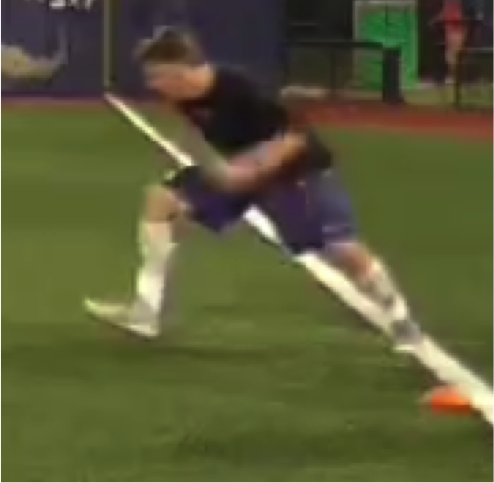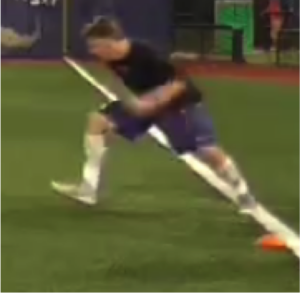
4 Strategies for Improved Base Stealing Jumps
Today’s guest post comes from former Cressey Sports Performance intern and current University of Washington Strength and Conditioning Coach, Dave Rak. Enjoy! -EC

Coaches often talk about gaining an extra step when it comes to improving speed. For a baseball player an extra step could be the difference between a stolen base or a jog back to the dugout. There are many ways to gain that valuable extra step. Strength training, drill work, and refining technique all play an important part. As a coach you need to help the athlete feel the correct positions in order to maximize efficiency when stealing bases. Here are 4 simple ways to improve common mistakes.
1. Videotape everything.
With almost everyone having a smartphone or a tablet device on them 24/7, cameras are easily accessible, which leaves no excuse as to why you can’t video tape your athletes. Whether you are working 1-on-1 with an athlete, or with all of your position players at once, video feedback will be crucial. This gives the athlete a view from your perspective as to how they could improve their movements. Video feedback will not only allow you to show the athlete what is going on from a technical standpoint, but in a team setting, it will allow you to work efficiently with large groups. As a coach you will be able to see every rep from each of your athletes. This allows you to go back, take notes, and identify what needs to be worked on for each player. The athlete can use this information to better correct movements and execute proper form.
Most importantly, having video allows you to study the athlete’s movement and learn what corrections need to be made. This grows your knowledge on this specific movement. You may not have all the answers right away, but video will help you and your athletes figure out what can be corrected. Video is nothing new in sports and especially baseball; why not use it when trying to gain an extra step on your steal jump?
Video programs such as Hudl Technique (formerly known as Ubersense) and Coach’s Eye are great apps that can be used on a smartphone or tablet to record video It can then be played back in different speeds for the athlete.
2. Overload the movement.
After breaking down video of my athletes I noticed some players were over reaching or stepping too high with their right foot on their initial leg drive. This is wasted movement that does nothing but prolong the steal jump, and put the athlete in a poor position to accelerate from. The photo below is an example of an ineffective directional step. The foot comes up too high, which prolongs the movement:

By taking a smaller and more direct step the athlete will achieve a better position for acceleration. Below is a video that shows an example of a more efficient step.
To help with this common mistake, you can physically pull the runner towards second base and overload the movement using a bungee cord attached at the waste as seen in the video below.
Lee Taft suggested told me about this drill, and it has been very helpful with allowing my athletes to figure out how to make that direction step more efficient. The pull of the bungee cord forces the runner to be quicker and more direct with their step. The pull of the cord will cause the athlete to shift their weight towards second base and onto the right foot. Once they take a directional step they have to replace the foot quickly, if they don’t they will fall. The bungee cord allows the athlete to feel their mistakes in the moment. After a few repetitions the athlete should be able to make the adjustment on their own.
NOTE: Bungee cords work better than jump stretch bands for these drills.
3. Gently resist the movement.
A lot of time is spent on developing power and becoming more explosive in the weight room. The initial push of the steal jump is a great place to show off these attributes. Using video feedback, you can easily see if an athlete is lacking that “push” when they take off for second base. Yelling “triple extension”, or “push harder” may not always work. Instead give the athlete something to push against. To do this take the bungee cord from our previous drill and instead of overloading the sprint, gently resist the start. This will make the athlete have to overcome the resistance of the bungee cord when they make their first move. This should force the athlete to get better extension with their left leg. The video below is an example.
Again, the bungee cord will work better than a pair of jump stretch bands.
The athlete should feel the resistance of the cord before they start their sprint. This will force them to be aggressive when they push off. The goal is for the athlete to feel how hard they need to push with the lower body. It is also important to note that too much resistance will change the outcome of the drill. We are not weighing down the runner and having the partner get dragged behind. The runner should have to overcome the resistance on the push off and then be able to run normally as they accelerate.
4. Use a towel to teach arm movement.
After speaking with Lee Taft about what I was seeing with my athletes I began to realize how important the arms are, especially in the initial move. Lee helped me to realize that by achieving better arm action, common mistakes will be corrected on their own. These mistakes include: popping up on their first move, weak initial push-off, inability to stay low through the acceleration phase, and not turning the body quick enough to get into a linear sprint.
To help get the athlete to become more aggressive and throw the arms on their initial move we can hold a towel or shirt behind him. One of my former players actually came up with this idea on the spot during a training session. We told him to knock the towel out of his partner’s hand, which forced him to drive his arm back in a more aggressive manner. Originally this athlete did not have an aggressive arm action from the start position, preventing him for getting his body turned efficiently. This drill is an exaggerated movement; keep in mind the goal is to get a feel for what his arms should be doing.
Throwing the arms too much can be a bad thing and can cause the runner to over rotate. Make sure to find a good middle ground.
In addition to the actual action of the arms, the hand placement is also important. Longer arms require a greater distance to be traveled which takes up more time. Instead of letting the arms dangle near the knees, try to move the hands to belt level. This shortens the path of the hands, therefore allowing the runner to drive their arms back faster. This will get he body turned in a quicker fashion.
The purpose of these drills is to allow the athlete to feel mistakes and then provide an opportunity to self-correct. When the runner gets out of position the bungee cords will provide instant feedback. The video will provide visual feedback as well. The towel drill forces the athlete to accomplish a movement with the arms that they previously may not have done. The ultimate goal is for the athlete to feel the correct technique for themselves and carry it over into game time situations.
About the Author
David Rak is in his third year as an assistant strength & conditioning coach at the University of Washington. David directly oversees sports performance for Baseball, Men’s & Women’s Golf, and Men’s Tennis. He can be reached at davidrak25@gmail.com.


